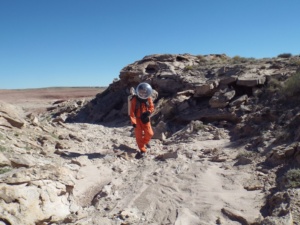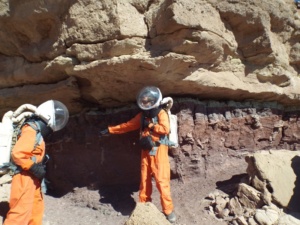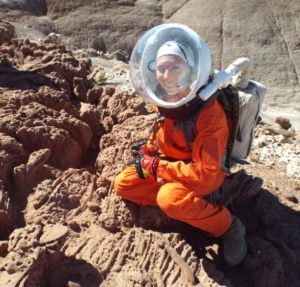EVA Journal – October 21st
MAPPING THE PAST
Jon Clarke
Geologist on the prowl
Today three of us took the ATVs to “Green Mars”, a beautiful lookout over Muddy Creek, the perennial stream that defines the northern boundary of the main MDRS area. Muddy Creek joins the Fremont River (which defines the southern boundary). Their combined flow makes the Dirty Devil River. I can’t speak for the devils, but it certainly is as dirty as Muddy Creek is muddy.
Palaeobiology in action-Jon and Anushree discussing possible Jurassic sub-social mammal burrows
After enjoying the view we started back and began the EVA’s field program. The prime focus was inverted channels identified in Google Earth imagery. Those within a km of the track were visited and the current directions determined from cross-bedding. Twelve locations were documented during the course of the EVA. Some of these proved to preserve interesting trace of Jurassic life. Most of these locations were only accessible on foot and could not be approached by wheeled vehicles.
Palaeobiology in action-Anastasiya sitting on a Jurassic ant nest
It’s important not to get tunnel vision during field science. So we were able to add two new locations for hypoliths (cynobacteria living beneath pebbles, mostly quartz) for future documentation. Also we were able to revisit a previously visited chasmolith (cyanobacteria living in cracks in rocks, usually sandstone) location. While probably closely related to hypoliths, chasmoliths provide a whole different set of challenges for their study. Both are analogues for how life might occur on Mars, or have occurred in the past. They were living in an inverted channel where the sandstone partings formed by the cross-bedding provide the niches for the chasmoliths to grow. Mapping palaeochannels helps us locate potential habitats for these extremophiles and illustrates the cross–disciplinary nature of field science. Geology provide the context for biology, which in turn influences the geology, especially how rocks weather and landscapes are shaped.
Beneath the harsh surface of this inverted sandstone channel is a seething mass of endoliths and chasmoliths.







